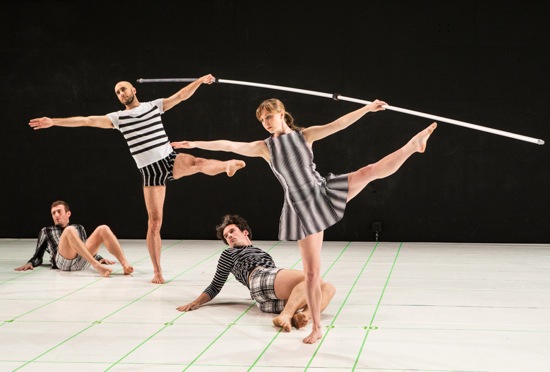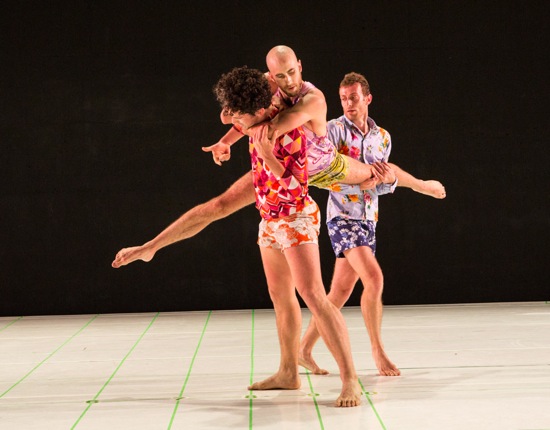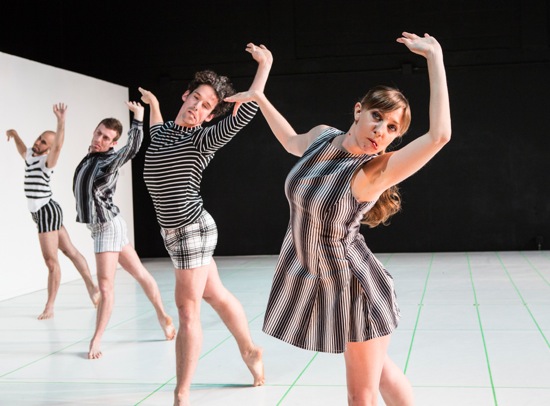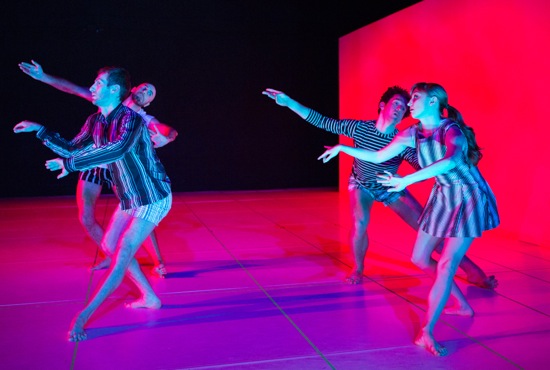John Jasperse brings diverse sources and his own history into a bold new work at New York Live Arts, May 28 through 31.

John Jasperse’s Within between. Standing: Burr Johnson and Maggie Cloud. On floor (L to R): Simon Courchel and Stuart Singer. Photo: Yi-Chun Wu
John Jasperse is not the kind of choreographer who draws a movement style out of his own body and sensibility and sticks with it. He reacts to ideas floating around in the culture, queries his own practice, tries something he hasn’t tried before. Often the movement he creates with and for his dancers is functional, whether the task at hand is moving books around, as it was in a scene in his 1997 Waving to You from Here, or sliding one naked body over another, as in his Fort Blossom (made in 2000, revised in 2012). He littered the stage with plastic bottles and other detritus in Misuse liable to prosecution (2007) and broke the famed fourth wall in Prone (2009) by having audience members lie on rows of clear plastic mattresses while performers danced strenuously over and between them.
His new Within between, which premiered at New York Live Arts, is by far the danciest work of his that I’ve seen. The stage is a pristine arena for it. Lenore Doxee, who created the lighting and visual design (the latter in collaboration with Jasperse), has covered the white floor with an green grid of different-sized rectangles; on either side stand two large, wall-high white blocks. The four dancers—Maggie Cloud, Simon Courchel, Burr Johnson, and Stuart Singer—initially wear snappy, variously patterned black-and-white outfits (briefs and shirts for the men, a short-skirted dress for Cloud); later, they exchange these for wildly colorful clothes that explode with floral or geometric motifs.

Stuart Singer (L) and Simon Courchel carry Burr Johnson in John Jasperse’s new work. Photo: Yi-Chun Wu
There is only one prop, but it’s a humdinger. Courchel begins by walking onto the stage and picking up an exceedingly long, slim, flexible pole. With immense care, he inserts it into the first rows of the audience (no one appears to wince or shrink away), chooses a seated target, and slowly makes the pole stroke its way from the person’s shoulder, over his/her head, and down to the other shoulder. He does this to two spectators. Think about the title of the piece. “Within” and “between” do not constitute a polarity; they probe (like the pole) at such concepts as inner feelings, relations among individuals and within a group, and mediation between artistic styles. Courchel’s act, with nice irony, sets the stage for both intimacy and distance.
The adventures of that pole call to mind the maneuvers in Trisha Brown’s 1973 Sticks, in which (usually) four women, keeping the ends of their longish sticks connected in one wobbly line, moved from lying beneath the sticks to stepping up and over them and returning to their initial positions. Jasperse, choreographing for four dancers and a single pole, may be alluding to Brown’s work, while referencing the task structures of his own plain early works and the barre that dominates a ballet class; in the process, he creates an imaginative and understatedly virtuosic sequence.
Singer joins Courchel for a duet in which together they shoulder the rod and, in unison, maneuver it in increasingly daring ways; now it’s on their shoulders, now it’s resting on the toes of their outstretched feet, now it’s caught on the crooks of their bent knees.
It’s at this point that a plucked string breaks the quiet and is followed by soft humming, sounds of a throat being cleared, a brief “okay.” Jonathan Bepler’s score for Within between is a marvel—full of mysteries, quietly chaotic. Sometimes it’s hard to tell which sounds are recorded and which are being produced by the four musicians, who sit close to the front row of spectators with their backs to us. Mick Barr and Eric Hubel are guitarists, Megan Schubert is described in the program as an “experimental vocalist,” and Bepler is adept on a number of instruments. The recorded music features numerous artists—most prominently, the Ohio State Marching Band and Claude Debussy’s “Clair de Lune,” recorded by pianist Jean-Efflam Bavouzet, the latter work at times transformed and merged with other sounds.
The voices escalate from whispers and become both more urgent and more organized, as Cloud and Burr join the other two dancers. At first these newcomers, standing, execute slow balances, while Courchel and Singer continue their adventure with the pole, but before long, the four have moved into double duets, and pole-bearing becomes a shared or exchanged job.

L to R: Burr Johnson, Simon Courchel, Stuart Singer, and Maggie Cloud in Within between. Photo: Yi-Chun Wu
One of Jasperse’s sources is ballet. While “Clair de Lune” plays for the first time, the performers stand in a diagonal line and, in unison, perform simple, precise balletic moves without a barre (the pole has been carried away). But the classical look briefly turns cranky. A curved arm angles itself, a pointed foot clubs, and sights and sounds become spookily disfigured. As the dancers move smoothly through material that has the look of a pre-ordained ritual, they gaze out of the corners of their eyes and drag down one corner of their mouths. Percussion patters in, strings get harshly strummed, and Doxsee turns everything red for a while.
The complexity of these conjunctions among sound, motion, light, and color increases, and the dancers (who are credited as collaborators in the choreography) expand the range of their movements, while also occasionally referring back to moves they’ve made before (what Courchel had the pole do in the way of a caress, for instance, can be replicated by a hand moving over a colleague’s head). The lighting, which has turned several of the rectangles on the floor yellow, then made the back wall green, gives Johnson and Singer the brightest of stages when they stop jiggling against each other and take off leaping across it.
Without warning, another reconfigured movement source crops up as the dancers move from two-part counterpoint into unison and advance on us, spraddle-legged and slapping their thighs and bodies rhythmically. The allusion may be to step-dancing, but it has none of that African-American form’s looseness-within-precision and jazzy edge. It also calls to mind the diverse ancestors of Stepping, like the Gumboots dancing of South Africa, and has a distant kinship with some Pacific Islanders’ stamping and clapping. But quickly it allies itself with the other elements in this community’s vocabulary, including the shifty gazes, the askew lower lip, and other facial expressions. At one point, Courchel and Singer carry on with the clapping and stepping and slapping, while Cloud and Johnson embark on what could (almost) pass for a slow-motion balance exercise in a ballet class.

John Jasperse’s Within between. Front: Simon Courchel and Maggie Cloud. Back (L to R): Burr Johnson and Stuart Singer. Photo: Yi-Chun Wu
I should emphasize that none of these borrowings seem eclectic; Within between is no postmodern pastiche in which anything can go with anything. It’s as if all the sourced material has been made into communal property and re-modeled according to the values of an open-minded society. The crossover footwork that often figures in Stepping mates with ballet’s croisé positions and anyone’s maneuvers in a cramped space. At one point the music—a strongly rhythmic orchestral segment—sounds as if Kurt Weill might have been composed it, but didn’t. At other times, it evokes a barnyard or a clutch of gossiping neighbors. The dancers (by now in their bright-colored attire) may leap about and perform other handsomely athletic steps, but with differences in timing and space patterns.
Other elements enter. Suddenly, the dancers are all smiles; “what fun this is!” they appear to tell one another. Singer and Courchel perform together for a while with their eyes shut. Singer then begins to talk, describing in an undertone the movements that they’re doing—a cliché unpacked from the early days of postmodern dance.
Within between is a wondrous work, made all the finer by the expertise and expressiveness of all involved. You can’t conveniently liken it to a patchwork quilt or a photo album or a collage. All the memories, styles, and structural ideas have been merged into an intriguingly original work, their diversities absorbed and re-imagined by Jasperse and the very individual performers. Embodiment takes on a new power. Within what and between what delineate a landscape of possibilities.

I’m very interested in what Jasperse is up to, but this comment
“Jasperse, choreographing for four dancers and a single pole, may be alluding to Brown’s work, while referencing the task structures of his own plain early works and the barre that dominates a ballet class; in the process, he creates an imaginative and understatedly virtuosic sequence.”
sent me in a different direction. I just saw Catherine Gund’s documentary on Elizabeth Streb (“Born to Fly”), which examined the choreographer’s history and included her work for the London 2012 Olympics art programming. Streb speaks about Trisha Brown’s equipment work, and dedicated a walk down the side of the London city hall to Brown — with the news of Brown’s retirement, and the discussion about the direction of her company and repertory, she’s in the air right now. Perhaps Brown is the one who’s currently flying.
I appreciate the fact that Sandi k’s mind flies off on various tangents. As does mine. We’re lucky that Trisha Brown’s pole dance has been revived every now and then, since each performance is different. Sometimes those women cannot get their poles to stay connected for more than a few minutes, and calls of “I’m off” ring out.
Speaking of tangents, I’m looking forward to seeing the Trisha Brown Company open Bard’s Summerspace Festival in late June with three works for proscenium stage. including the 1983 “Set and Reset.” Trisha Brown’s mind has always flown. Aren’t we lucky!
“seeing the Trisha Brown Company open Bard’s Summerspace Festival in late June with three works for proscenium stage. including the 1983 “Set and Reset.” Trisha Brown’s mind has always flown. Aren’t we lucky!”
Yes indeed — please come back and tell us all about it.